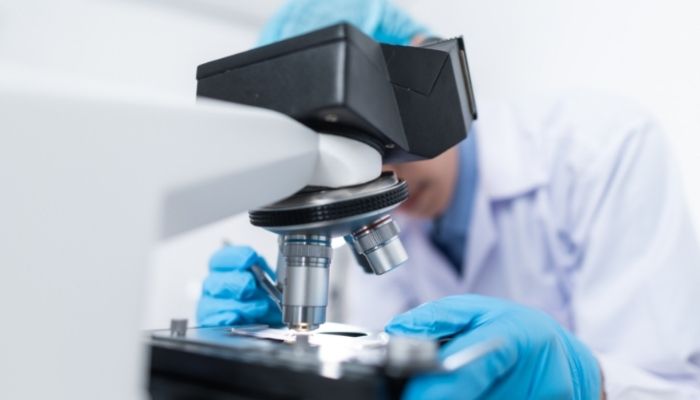|
Elevated levels tied to more severe interstitial lung disease by Patricia Inácio, PhD Elevated blood levels of the cold-inducible RNA-binding protein (CIRP) are linked with more severe interstitial lung disease (ILD) in systemic sclerosis (SSc) patients and may be a marker of disease activity, a study from Japan reports. “Our results suggest that serum [blood] CIRP levels may serve as a useful serological marker of SSc-ILD in terms of disease activity and therapeutic effects,” the researchers wrote. These findings “hold the potential to pave the way for a novel design for the treatment of patients with SSc-ILD.” The study, “Serum cold-inducible RNA-binding protein levels as a potential biomarker for systemic sclerosis-associated interstitial lung disease,” was published in the journal Scientific Reports Protein’s levels a potential blood marker of SSc-ILD progression ILD comprises a group of lung disorders marked by inflammation and fibrosis (scarring) that causes lung tissue to thicken and stiffen, restricting the volume of air that enters and leaves the lungs. While blood biomarkers have been proposed, “few of them could help estimate the progression of SSc-ILD,” the researchers wrote. Cells in damaged tissues release warning signaling molecules — called damage-associated molecular patterns (DAMPs) — as a way of alerting and activating the immune system. Several DAMPs have been reported to be involved in SSc. The CIRP protein, recently identified as a DAMP, has rising levels following exposure to stressors such as low oxygen levels, UV radiation, and glucose (sugar) deprivation. CIRP, a “general stress-response protein,” is found in several tissues, including the skin, lungs, and heart. While the protein recently was implicated in the development of idiopathic pulmonary fibrosis, its role in SSc is not well known. Researchers with the University of Tokyo measured CIRP levels in blood samples from 60 SSc patients — median age of 56; 56 women and four men — and analyzed potential links with disease symptoms. Samples also were collected from 20 healthy people serving as controls.
CIRP levels of SSc patients were significantly elevated compared with controls, a median of 2.94 versus 2.23 nanograms (ng)/mL, results showed. Within the SSc group, patients with diffuse cutaneous SSc had significantly higher CIRP levels in their blood than did those with limited cutaneous SSc (lcSSc), a median of 7.40 versus 2.19 ng/mL. No significant differences were seen between CIRP levels in lcSSc patients and controls. CIRP levels showed no association with skin thickness scores or with skin vascular symptoms, such as Raynaud’s phenomenon, nail fold bleeding, and digital ulcers. Moreover, no link was found in patients with problems in the working of the esophagus (the tube connecting the throat with the stomach), heart involvement, and scleroderma renal crisis — a complication characterized by sudden high blood pressure and kidney failure. No link was seen between elevated CIRP levels and the presence of anti-centromere and anti-RNA polymerase III autoantibodies. In contrast, patients positive for anti-topoisomerase I autoantibodies, also characteristic of SSc, had higher CIRP levels than those without such antibodies (6.05 vs. 2.14 ng/mL). CIRP levels higher in SSc patients with ILD than those without lung diseaseSSc patients with interstitial lung disease also had significantly higher CIRP levels than those without ILD, 6.65 versus 2.32 ng/mL. Further analyses showed that higher CIRP levels correlated with a lower percent predicted diffusing capacity for carbon monoxide (%DLCO), a measure of the lungs’ capacity to transfer oxygen from the air sacs into the blood. Higher CIRP levels also associated with higher amounts of an ILD blood maker called KL-6, generally associated with fibrotic progression. No significant correlation was seen for another ILD marker, called SP-D. Researchers then explored the effects of disease treatment on CIRP levels. For that purpose, they analyzed CIRP levels in four SSc patients before and after treatment with corticosteroids or other immunosuppressants, including intravenous (into-the-vein) cyclophosphamide pulse therapy and Actemra (tocilizumab). CIRP blood levels fell significantly after immunosuppressive treatment. Three of these people also showed an increase in %DLCO, indicating better lung function, while the fourth had a %DLCO decrease. One treated patient also had a marked reduction in ground-glass opacities evident on a chest CT scan, indicative of an easing in SSc-ILD. “Here we showed that serum CIRP levels were increased in the serum of SSc patients. Moreover, increased serum CIRP levels were associated with greater frequency and severity of SSc-ILD, while not with other clinical manifestations of SSc,” the researchers wrote. Among limitations of this single-center study, the researchers noted, were the relatively small number of patients involved, especially for analyses comparing different SSc groups, like patients with and with ILD. Comments are closed.
|
AuthorScleroderma Queensland Support Group Archives
July 2024
Categories
All
|
Scleroderma Association of Queensland
©Scleroderma Association of Queensland. All rights reserved. Website by Grey and Grey.

